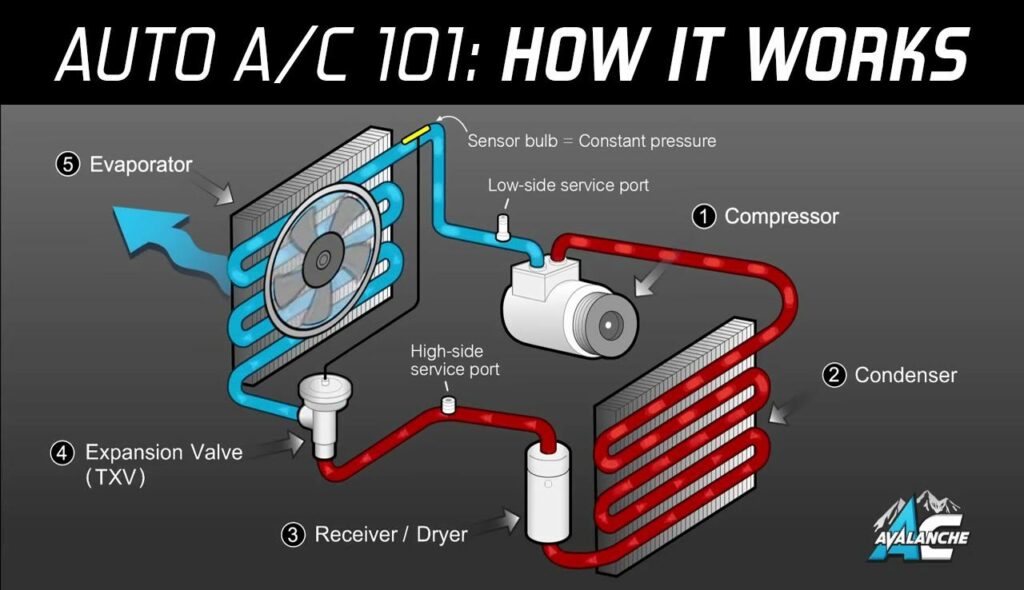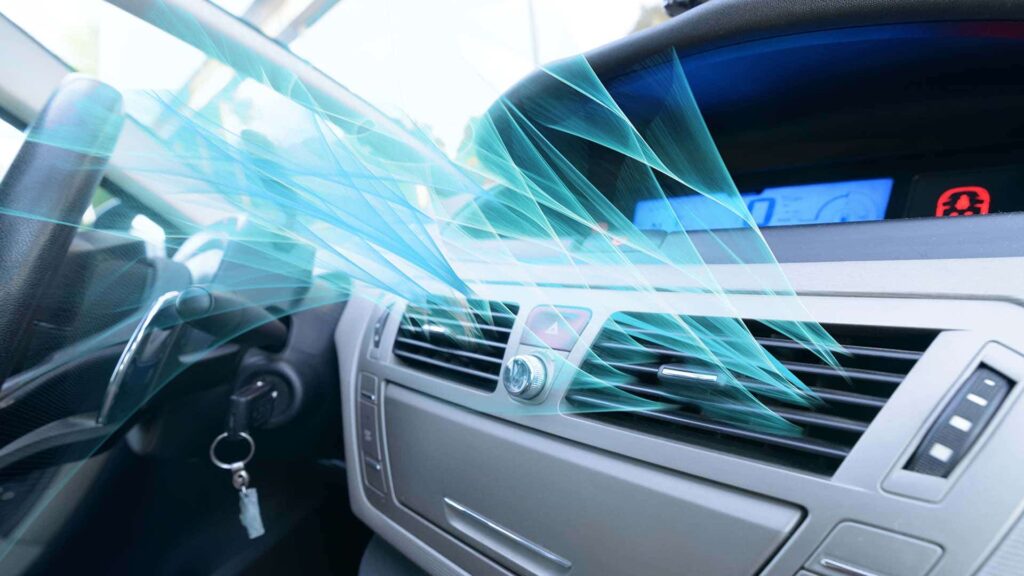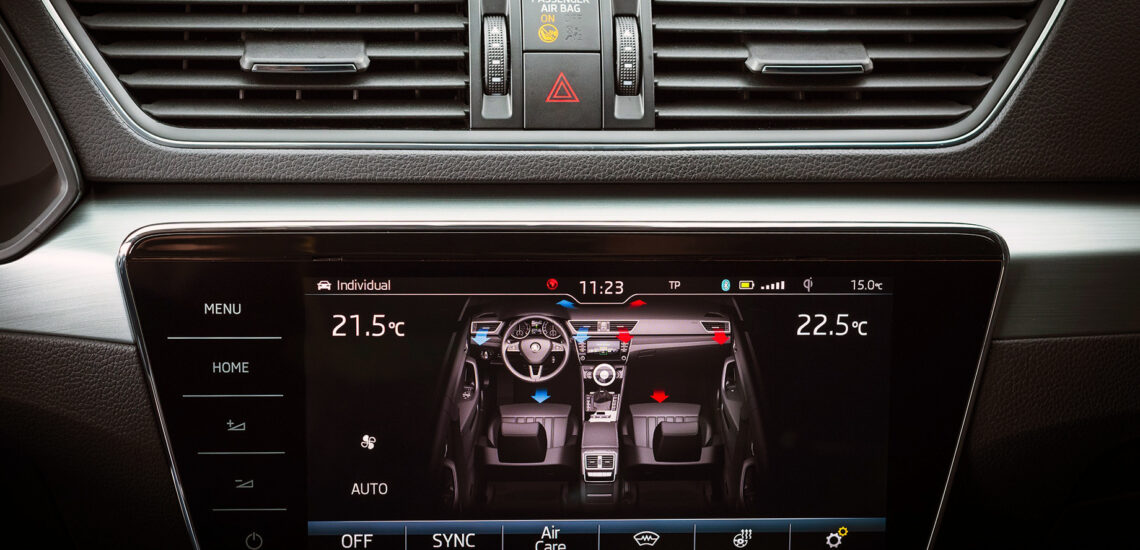Належний мікроклімат в салоні автомобіля – це не тільки питання комфорту. Якщо температура в кабіні підвищується з 25 °C до 35 °C, час реакції водія збільшується приблизно на 20%. Наприклад, у SEAT вважають, що «перегрітий» водій небезпечний так само, як і п’яний з вмістом алкоголю в крові 0,5 проміле. Крім того, системи клімат-контролю допомагають підтримувати чистоту вікон автомобіля. Все це питання не тільки комфорту, а й безпеки.
Парадокс полягає в тому, що потужність обігрівачів і кондиціонерів досягає 8-10 кВт, а для підтримки комфортної температури тіла людини необхідно в 50-100 разів менше. Справа в тому, що основна енергія доводиться витрачати на обігрів або охолодження самого автомобіля, зокрема елементів салону. Близько третини поверхні тіла пасажира стикається з сидінням ― тому підігрів або вентиляція (охолодження) сидінь при низьких енерговитратах дає великий ефект. Але в будь-якому випадку кліматична система повинна подавати не менше п’яти-десяти кубометрів повітря в хвилину в залежності від розміру автомобіля.
Вважається, що найкомфортніша температура в салоні – від 18 до 22 °C. Це усереднене значення, тому що в місці ближче до підлоги повинно бути на п’ять-вісім градусів тепліше, ніж в області голови. Це наша фізіологія. Адже не дарма бабуся в дитинстві надягала на вас теплі шкарпетки: перш за все, потрібно зігріти ноги. А що стосується літа, то найефективніше охолоджувати груди, спину і руки. Тому основний потік гарячого повітря при опаленні повинен бути спрямований вниз, а холодного влітку – в центральні вентиляційні отвори. До речі, з їх допомогою також найбільш ефективно охолоджується задня частина салону.
Цифри, які ви встановлюєте на автоматичному клімат-контролі, – це лише свого роду умовний показник комфорту, а не точна температура в градусах Цельсія. У різних куточках світу люди мають свої звички та уявлення про комфорт, і виробники автомобілів це враховують. Така ж фактична температура в салоні може відповідати 20-22 градусам, встановленим на панелі управління європейського автомобіля, і 22-24 градусам ― у автомобілі азіатської марки. Тому, пересівши з Фольксвагена на Ніссан, не дивуйтеся, що ви холоднієте при звичній цифрі 22 на дисплеї.
Ручне керування напрямком подуву також є певною мірою ілюзією. Навіть якщо мова йде про машину з прямим механічним управлінням обігрівачем, наприклад, переведення ручки в положення «ніжки» означає лише те, що основний потік повітря буде спрямований вниз. 10-20% повітря все одно буде надходити на лобове та бічні вікна, щоб вони не запотівали, а різниця температур між верхнім і нижнім шарами не ставала дискомфортною. Зараз практично всі обігрівачі та кондиціонери досить потужні, і різниця між поганими і хорошими системами полягає саме в нюансах таких тонких налаштувань.
Безумовна перевага – роздільний клімат-контроль. Однак за однією назвою ховаються системи різного ступеня досконалості. У недорогих автомобілях індивідуально можна змінювати лише температуру. Водій, якому необхідно розморозити бічні вікна, неминуче забере тепло від ніг пасажирів. Передові системи також дозволяють контролювати напрямок і інтенсивність обдування. І навіть тонко встановити різницю температур шарами.

«Обличчям» клімат-контролю є його панель управління. Ми вважаємо, що він повинен бути організований логічно і розрахований на руки в рукавичках. Добре, коли навіть в автоматичному режимі на дисплеї видно, куди і як дме кліматична установка, а не горить тільки Auto — це позбавляє вас від зайвих маніпуляцій. Для Росії, наприклад, особливо важливо те, що рециркуляцію повітря можна легко ввімкнути на дотик ― ймовірність «натрапити» на трасі на задимлений КамАЗ або карбюраторний «Пазік», не зумівши їх наздогнати. кілька кілометрів, дуже висока. Єдиний спосіб вберегтися від кіптяви і смороду в салоні – закрити заслінку рециркуляції.
Навіть найпростіші автоматичні системи мають датчик сонячного випромінювання, оскільки наше сприйняття температури змінюється, коли сонячне світло контактує з нашою шкірою. Більш дорогі автомобілі можуть мати кілька таких датчиків. А також інфрачервоні датчики запотівання вікон (лобового та передніх бічних вікон), якості повітря, кількості вуглекислого газу в салоні, інформації від навігаційної системи, наприклад, про тунелі… Просунуті системи оцінюють температуру в різних місцях усередині блоку HVAC. Взагалі температура в салоні дійсно постійно змінюється ― але якщо клімат-контроль налаштований ідеально, ми цього не помічаємо.
У більшості автомобілів клімат-контроль працює більш адекватно, ніж у звичайного водія, який регулює мікроклімат вручну. Ті, хто регулярно користується таксі, напевно знають, що лише деякі водії розуміють, що і як робити. Найпоширенішими помилками є подача гарячого повітря не в напрямку ніг, а вгору і повне відключення вентилятора. Недостатній повітрообмін і неправильний розподіл температури в салоні – це шлях до втоми і втрати вже згаданого адекватного часу реакції. Вимикати вентилятор немає сенсу: кліматична система фактично перестає працювати взагалі.
Тому найголовніша порада: не заважайте роботі автомобіля! Встановіть комфортний показник температури, натисніть кнопку Auto і нічого не чіпайте. Але спочатку потрібно дозволити автоматиці працювати максимально ефективно – відкрити всі дефлектори, не загороджувати датчики і не відкривати вікна та люк. Однак, якщо не жарко і немає загрози запотівання вікон, можна вручну вимкнути кондиціонер. Багато сучасних компресорів плавно регулюють свою продуктивність і не збільшують споживання палива так різко, як це було 20 років тому. Однак фізику не обдуриш: кондиціонер все одно дає кілька відсотків збільшення споживання.
Сучасні агрегати HVAC (Heating, Ventilation, Air Conditioning) – тобто власне «комбайни», які готують і подають повітря в салон – розраховані на постійне використання кондиціонера. Поняття «клапан обігрівача» фактично пішло в минуле ― у більшості автомобілів охолоджуюча рідина циркулює в радіаторі обігрівача як взимку, так і влітку. Утеплювач іноді послідовно «вбудовується» в мале коло системи охолодження, через нього проходить вся рідина, а в мороз утеплювач починає грітися раніше і інтенсивніше. Це робиться навіть на автомобілях ВАЗ. Але влітку гарячий радіатор, навіть закритий заслінками, також частково зігріває забортне повітря ― і рука тягнеться до кнопки A/C.
Загалом, гріти машину простіше не стає. Чим ефективніші та екологічніші сучасні двигуни, тим менше тепла вони виділяють. Щоб швидко розігріти салон, доводиться вдаватися до хитрощів ― грати з моментом запалювання, використовувати часткову рециркуляцію повітря і більш дорогі пайки радіаторів. Електричні обігрівачі двигунів, які колись використовувалися лише з холодними дизелями, а тепер необхідні для паливноефективних малооб’ємних турбодвигунів, є ефективними.
Це не спіральні ТЕНи, як на дачі у бабусі, а так звані PTC-резистори, де PTC означає «позитивний температурний коефіцієнт». Нагрівальний елемент виконаний з легованої полікристалічної кераміки на основі титанату барію, а справа в тому, що сама його продуктивність змінюється в залежності від температури. Вони працюють при температурі близько 270 °C, а ефективність може перевищувати 90%! Зазвичай в легкових автомобілях використовуються PTC-нагрівачі потужністю близько 1-1,5 кіловат.
Конструктивно блоки ОВК практично не змінюються, але вдосконалюються в дрібницях. Наприклад, вони працюють тихіше і ефективніше – завдяки безщітковим двигунам вентиляторів, встановленим на м’яких опорах, а також спеціальному покриттю дефлекторів. Системи «Старт-стоп» зумовлюють використання випарників кондиціонерів з термоакумуляторами — герметичними трубками з рідиною, залитою в серцевину: щоб прохолода була доступна деякий час після вимкнення двигуна. Все частіше використовуються дефлектори, в яких можна змінювати не тільки напрямок і інтенсивність потоку, але і його «фокус».
Нові підходи з’являються лише через зростання популярності електромобілів. Тут від кліматичної системи потрібна ефективність. П’яти хвилин роботи шестикіловатного обігрівача Tesla Model S вистачає, щоб «вкрасти» близько трьох кілометрів ходу. Замість традиційних систем має сенс використовувати теплові насоси, тобто «кондиціонування повітря навпаки».

Виробники починають економити навіть на дрібницях: автоматика активно використовує режим рециркуляції, щоб не витрачати енергію на приведення повітря, що надходить «в належний стан». Є системи, які відключають повітрообмін в певних місцях кузова автомобіля, якщо там ніхто не сидить. Загалом добре, коли важливі системи автоматизовані і забирають у водія частину рутини. Проблема тільки в тому, що повністю адекватні кліматичні системи зустрічаються тільки в преміум сегменті. І справа не лише в кількості датчиків чи потужності PTC-нагрівача, а й у налаштуваннях та досвіді автовиробника… Тому будьте пильні, натискаючи кнопку Auto.
Це переклад. Оригінал можна прочитати тут: l https://www.drive.ru/technic/5eb26b30ec05c4794c0000c3.html

Опубліковано Серпень 26, 2021 • 7хв на читання






